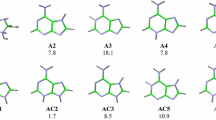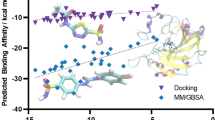Abstract
Vectorial proton transfer among carbonyl oxygen atoms was studied in two models of tripeptide via quantum chemical calculations using the hybrid B3LYP functional and the 6-31++G** basis set. Two principal proton transfer pathways were found: a first path involving isomerization of the proton around the double bond of the carbonyl group, and a second based on the large conformational flexibility of the tripeptide model where all carbonyl oxygen atoms cooperate. The latter pathway has a rate-determining step energy barrier that is only around half of that for the first pathway. As conformational flexibility plays a crucial role in second pathway, the effect of attaching methyl groups to the alpha carbon atoms was studied. The results obtained are presented for all four possible stereochemical configurations.





Similar content being viewed by others
References
Pelmenschikov V, Blomberg M, Siegbahn P (2002) A theoretical study of the mechanism for peptide hydrolysis by thermolysin. J Biol Inorg Chem 7:284–298
Rodiquez C, Cunje A, Shoeib T, Chu I, Hopkinson A, Siu K (2000) Solvent-assisted rearrangements between tautomers of protonated peptides. J Phys Chem A 104:5023–5028
Rodriquez C, Cunje A, Shoeib T, Chu I, Hopkinson A, Siu K (2001) Proton migration and tautomerism in protonated triglycine. J Am Chem Soc 123:3006–3012
Paizs B, Suhai S (2001) Theoretical study of the main fragmentation pathways for protonated glycylglycine. Rapid Commun Mass Spectrom 15:651–663
Paizs B, Csonka I, Lendvay G, Suhai S (2001) Proton mobility in protonated glycylglycine and N-formylglycylglycinamide: a combined quantum chemical and RKKM study. Rapid Commun Mass Spectrom 15:637–650
Smith R, Loo J, Barinaga C, Edmonds C, Udseth H (1990) Collisional activation and collision-activated dissociation of large multiply charged polypeptides and proteins produced by electrospray ionization. J Am Soc Mass Spectrom 1:53–65
Campbell S, Rodgers M, Marzluff E, Beauchamp J (1995) Deuterium exchange reactions as a probe of biomolecule structure. Fundamental studies of cas phase H/D exchange reactions of protonated glycine oligomers with D2O, CD3OD, CD3CO2D, and ND3. J Am Chem Soc 117:12840–12854
Cassady C, Carr S, Zhang K, Chungphillips A (1995) Experimental and ab-initio studies on protonations of alanine and small peptides of alanine and glycine. J Org Chem 60:1704–1712
Chaudhuri C, Jiang J, Wu C, Wang X, Chang H (2001) Characterization of protonated formamide-containing clusters by infrared spectroscopy and ab initio calculations. II. Hydration of formamide in the gas phase. J Phys Chem A 105:8906–8915
Csonka I, Paizs B, Lendvay G, Suhai S (2000) Proton mobility in protonated peptides: a joint molecular orbital and RRKM study. Rapid Commun Mass Spectrom 14:417–431
Martin R (2001) In: Sigel A (ed) Probing of proteins by metal Ions and their low-molecular-weight complexes (Metal Ions in Biological Systems, vol 38). CRC Press, Boca Raton, pp 1–23
MacDonald B, Thachuk M (2008) Gas-phase proton-transfer pathways in protonated histidylglycine. Rapid Commun Mass Spectrom 22:2946–2954
Fu H, Fu A (2007) Theoretical study on the reaction mechanism of proton transfer in alaninamide. J Mol Struct THEOCHEM 818:163–170
Richard J, Amyes T (2001) Proton transfer at carbon. Curr Opin Chem Biol 5:626–633
Hur O, Niks D, Casino P, Dunn M (2002) Proton transfers in the beta-reaction catalyzed by tryptophan synthase. Biochemistry 41:9991–10001
Tomashek J, Brusilow W (2000) Stoichiometry of energy coupling by proton-translocating ATPases: a history of variability. J Bioenerg Biomembr 32:493–500
Senior A (1990) The proton-translocating atpase of Escherichia coli. Annu Rev Biophys Bioeng 19:7–41
Green MK, Lebrilla CB (1997) Ion-molecule reactions as probes of gas-phase structures of peptides and proteins. Mass Spectrom Rev 16:53–71
Papayannopoulos I (1995) The interpretation of collision-induced dissociation tandem mass-spectra of peptides. Mass Spectrom Rev 14:49–73
Barber M, Bordoli R, Sedgwick R, Tyler A (1981) Fast atom bombardment of solids (fab): a new ion-source for mass-spectrometry. J Chem Soc Chem Commun 325–327
Hillenkamp F, Karas M, Beavis R, Chait B (1991) Matrix-assisted laser desorption ionization mass-spectrometry of biopolymers. Anal Chem 63:A1193–A1202
Fenn J, Mann M, Meng C, Wong S, Whitehouse C (1990) Electrospray ionization: principles and practice. Mass Spectrom Rev 9:37–70
Kulhanek P, Schlag E, Koca J (2003) A novel mechanism of proton transfer in protonated peptides. J Am Chem Soc 125:13678–13679
Kulhanek P, Schlag E, Koca J (2003) Mechanism of proton transfer in short protonated oligopeptides 1N-methylacetamide and N-2-acetyl-N-1-methylglycinamide. J Phys Chem A 107:5789–5797
Becke A (1993) Density-functional thermochemistry. 3. The role of exact exchange. J Chem Phys 98:5648–5652
Lee C, Yang W, Parr R (1988) Development of the Colle–Salvetti correlation-energy formula into a functional of the electron-density. Phys Rev B 37:785–789
Miehlich B, Savin A, Stoll H, Preuss H (1989) Results obtained with the correlation-energy density functionals of Becke and Lee, Yang and Parr. Chem Phys Lett 157:200–206
Hehre W, Ditchfie R, Pople J (1972) Self-consistent molecular-orbital methods. 12. Further extensions of Gaussian-type basis sets for use in molecular-orbital studies of organic molecules. J Chem Phys 56:2257–2261
Harihara P, Pople J (1973) Influence of polarization functions on molecular-orbital hydrogenation energies. Theor Chim Acta 28:213–222
Clark T, Chandrasekhar J, Spitznagel G, PvR S (1983) Efficient diffuse function-augmented basis-sets for anion calculations. 3. The 3-21 + G basis set for 1st-row elements, Li-F. J Comput Chem 4:294–301
Frisch MJ, Trucks GW, Schlegel HB, Scuseria GE, Robb MA, Cheeseman JR, Zakrzewski VG, Montgomery JA Jr, Stratmann RE, Burant JC, Dapprich S, Millam JM, Daniels AD, Kudin KN, Strain MC, Farkas O, Tomasi J, Barone V, Cossi M, Cammi R, Mennucci B, Pomelli C, Adamo C, Clifford S, Ochterski J, Petersson GA, Ayala PY, Cui Q, Morokuma K, Salvador P, Dannenberg JJ, Malick DK, Rabuck AD, Raghavachari K, Foresman JB, Cioslowski J, Ortiz JV, Baboul AG, Stefanov BB, Liu G, Liashenko A, Piskorz P, Komaromi I, Gomperts R, Martin RL, Fox DJ, Keith T, Al-Laham MA, Peng CY, Nanayakkara A, Challacombe M, Gill PMW, Johnson B, Chen W, Wong MW, Andres JL, Gonzalez C, Head-Gordon M, Replogle ES, Pople JA (1998) Gaussian 98, revision A.9. Gaussian Inc., Pittsburgh
Ayala P, Schlegel H (1998) Identification and treatment of internal rotation in normal mode vibrational analysis. J Chem Phys 108:2314–2325
Desiraju G, Steiner T (1999) The weak hydrogen bond in structural chemistry and biology. Oxford University Press, Oxford
Acknowledgments
The access to the MetaCentrum supercomputing facilities provided under the research intent MSM6383917201 is appreciated. This work was supported by the Ministry of Education of the Czech Republic, under contracts MSM0021622413 and LC06030 (J.K.). The research leading to these results also received funding from the European Community's Seventh Framework Programme under grant agreement no. 205872 (P.K.).
Author information
Authors and Affiliations
Corresponding author
Electronic supplementary material
Below is the link to the electronic supplementary material.
ESM 1
(DOC 33 kb)
Rights and permissions
About this article
Cite this article
Soliman, N.A., Kulhánek, P. & Koča, J. Influence of stereochemistry on proton transfer in protonated tripeptide models. J Mol Model 18, 871–879 (2012). https://doi.org/10.1007/s00894-011-1116-2
Received:
Accepted:
Published:
Issue Date:
DOI: https://doi.org/10.1007/s00894-011-1116-2




